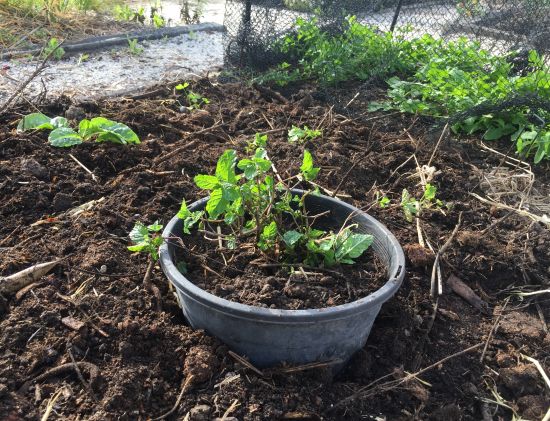First day of the First Quarter moon phase and two biggish jobs have been done.
Firstly, now is a great time to plant out strawberries. We’ve made our plants out of runners from last year’s plants, but they are also available now in the shops.
The bed the strawberries is destined for this year has had our long-term leafy greens in it, so first we had to set up a new long-term leafy green bed.

The new bed for the long-term leafy greens is where the kumara were. I had put some straw over the soil after the kumara harvest to keep it moist and weed-free. So in readiness for planting out, first I cleared away the straw and aerated the soil with a fork, then I trenched in organic matter from our Hungry Bin, then a layer of homemade compost which is quite chunky this time, then over the top of that a commercial compost, some chicken manure and Natures Organic Fertiliser which is full of vitamins and minerals, and I worked that all in together. Then in went 3 Cavolo Nero kale, 3 silverbeet, 3 parsley and a chopped-off piece of our old mint. We plant our mint in a pot which has had its bottom cut out and it does a magnificent job of containing the mint. Otherwise its spreading nature can be a real nuisance.



So with that done I harvested the silverbeet in the old bed, kept some for us for a green pie, and took the rest round to our local Pataka Kai.

The trunks of 6-month old silverbeet are huge but easy to chop up when fresh to go on the biomass pile for the next hot compost.
Even though I’ve planted new parsley, the old plants are so glorious I was really reluctant to pull these ones out, and fortunately there was enough room for the 18 strawberry plants in between the parsley and leeks. They need at least 25cms between each plant.
It’s worth preparing your strawberry bed well. So while we do that, soak your plants in diluted liquid seaweed to get them off to a good start.

Firstly I aerate the soil with a fork, then add compost. In our 1100mm wide bed we can fit 3 mounded rows. But first we start with 3 trenches. Into the trench goes a nitrogen fertiliser like chicken manure or sheep pellets for the plants’ roots to find once the plants are established.

Then work the soil back over the fertiliser to create a mound. Strawberries do best planted on a mound, for good drainage and slightly elevated soil temperature. Pop your plants in on the mounds. Then we apply some Natures Organic Fertiliser round each plant.

Water the plants in with the remaining liquid seaweed, then I fill the trenches in with barley straw (any kind of mulch will do), then layer a bit more straw round the plants and water that all in. Finally netting goes over the top to keep them safe from birds and cats.



The next job was sowing one of our beds with a green manure crop. I’ve chosen the bed that had the capsicums, eggplants and Roma tomatoes in it. It was just a matter of clearing it, then broadcasting the seeds. I’m using the tried and tested Blue Lupins again this year. Broad beans is another good green manure crop as you can enjoy eating the beans as well. If your soil is nice and fine, you could rake the seeds in, but ours is quite chunky, so I just watered the seeds in and covered the bed with netting.


Our tamarillo has been set upon by aphids, so I’m applying Neem Tree Oil to it every 3 days. It’s had 3 applications now which is usually enough, but I’ll keep an eye on it in case it needs another one or two. So while we’re not feasting on our own tamarillos, there are plenty in at our Farmers Market, so just as our feijoas come to an end we’re able to enjoy tamarillos now for breakfast!


Happy gardening from Jan and Rob!
Website designed by www.thecornerstorecollective.com
Developed by Richard Hpa
8 Responses
Thank you for your very helpful and informative posts.
Any chance you could tell us about the hoops and net system you use to protect your beds?
I have a very exposed garden so need to also protect from Southerlies but haven’t found a hoop/ net system that is easy to use.
Nga mihi
Michelle
Hi Michelle Yes of course. Have a look at this video of Rob making the hoops… https://organicediblegarden.co.nz/2017/02/16/17-february-2017/ And here’s Paul making them in our Containers series… https://organicediblegarden.co.nz/2020/10/26/3-planting-out-part-1/#more-11371 We usually use weedmat pins to hold the netting down firmly. Feel free to ask any questions that these videos don’t answer 😊
Perfect, Nga mihi 🙂
Hello, I have your 2022 calendar and in may you recommend side dressing beetroot with rock dust to speed up the development of the roots. In the past I have had trouble with beetroot sitting in the ground and not developing roots. Is EF base 50 (parmagnetic rock dust)good for this purpose?
Many thanks
Julie
Yes it’s good. Any fertiliser that has phosphorus in it will help roots develop. Have a look at EF’s Natures Organic Fertiliser https://organicediblegarden.co.nz/product/natures-organic-fertiliser/ though as it has other vitamins and minerals in it, along with the paramagnetic rock dust, which will ultimately be better for the soil, as it’s more balanced.
Hi there is this fertiliser still available? Natures organics fertiliser? I’m wanting to use some over my tomatoes plants as per your videos? I can’t seem to find it online.
Thank you so much. I have some natures organic fertilserso will give that a go.
Perfect 😊